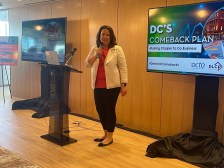The keys to increasing diversity in tech? STEM education and removing gender bias, D.C. CTO says

When Archana Vemulapalli talks about her upbringing, she calls herself “fortunate.”
The chief technology officer for Washington, D.C., who lived in India until her 20s, said her family did not prescribe gender roles upon its three children — Vemulapalli and her older sister and brother — and instead welcomed whatever they wanted to do.
“My parents, amazingly, had no expectations, which was the best thing you could do to a child,” Vemulapalli told StateScoop in an interview about her life, her career and diversity in the government information technology workforce.
As she progressed through school, Vemulapalli eventually settled on engineering. One of her first internships brought her to a satellite communications company.
“I was the only woman doing that, but [my parents] never said, ‘It’s something you shouldn’t do,’” Vemulapalli said. “I could do whatever I wanted. Growing up with that, and not knowing that something is not an option is very empowering.”
The National Center for Women in Technology reported that women comprise just 25 percent of professional computing occupations. And as of March 1, only only six women held state chief information officer roles across all 50 states and the District of Columbia.
StateScoop asked Vemulapalli about this disparity and how it might be corrected.
StateScoop: Why are women are severely underrepresented in technology?
Archana Vemulapalli: The focus always tends to be women in technology, but really, the focus needs to shift to the men, because if the right person, regardless of gender, gets a fighting chance at an opportunity, you will never have that issue. You will not be judged on the way you look, the way you talk, the pitch of your voice or what you wear, or what you bring to work.
When you study engineering, there is no gender bias in the subject itself. There is no bias in how you approach decision-making or how you write your algorithm, and so it’s really important to get past that and I really think you have to fix how men approach women in engineering. It’s not how women approach women in engineering. When I see a woman engineer, I don’t say, ‘Oh, is she qualified?’ Nine times out of 10, it’s not the women that think that, and they need to fix the men that think that. And that’s what needs to happen.
Most of the events I go to where they’re trying to promote women engineering or women in technology, it’s only women sitting there. The men need to show up. What’s the point of having an event to say, “We need to have women in bigger roles” and then 90 percent of the audience is women? The people who need to change the attitude are not there. I think that needs to shift.
It’s one thing from a support-group standpoint. That’s OK, but if you don’t put it prime time on center stage or make it your keynote issue, you’re not going to address the issue. I think until that shift happens, we’re always going to be discussing this as a one-off.
So, what needs to happen to change it?
There are issues at multiple levels. The idea of science, technology and engineering and making that interesting has to happen at an early stage. If you think from the stereotype of [buying toys for] kids, you will see Legos for the boy and get dolls for the girls.
You are already training a child’s mind to be logical and structured about certain things and you’re catering a different message to a different gender — right there is an opportunity. You can start early on. A lot of the coding academies for girls are trying to do that. You need to appeal at a younger age, even when they’re in middle school or in kindergarten. There are applications, there are things you can do, there are ways to engage girls — they don’t necessarily get engaged. That’s the education part of it, early education and reinforcing that science and technology are as important as arts. I actually think you can’t leave arts out, because it has to be in the same conversation as both of them. It gives you the breadth of exposure and helps build your awareness.
Then when you look at your career in mainstream, the majority of the technology industry is men. That’s a known fact. So when you have a smaller group, how do you motivate more people to get in when they see an opportunity to succeed. When you look at something and look at the path and say, “I can do it,” that’s when you get in. But if you see consistently situations where women are not in major roles, you will see more women in technology in major companies as chiefs of staff than CEOs — why is that?
Put more women on your technology boards. This is where men can make an effort to hire people. In your team, when you look across your team and it’s all guys, make an effort to go find a woman to hire. Figure out how you can get a perspective that’s different. It’s not that you have to pick a woman because it’s a woman — pick the qualified woman. But make the effort to look, and when you start doing that is when you start breaking the dynamic.
If I come in as an engineer and I’m working really hard, and you come in and you, [a man] are working equally hard, or maybe even 10 percent less than I am, but you get the promotion over me every single time because you can go play golf or smoke a cigarette that I’m not interested in? Guess what just happened?
Have you seen that happen?
That happens all the time. Look, it’s human nature. People will tend to congregate with people they know and that they’re comfortable with. If it’s group of guys talking about sports — that’s been the nemesis of my life. I have no clue about sports. In my first job, I would read the sports section just so I would look like I know something, but they would catch me 30 seconds into it and be like, “You don’t know anything. Sit back down.”
Really?
Oh yeah. I would read the sports section and be like, “What about the Eagles?” They’d be like, “Do you even know what they play?” I was like, “I have no idea. I just read the news. I’m trying to catch up with you guys.” They were amused that I even tried, and so that broke the ice and my team just took me in, but I was the only woman in a team of 12 engineers.
You learn different ways to break the ice. It’s just one of those things. These things happen, but over time you are conscious of these things. You adjust. It’s not that anyone approaches this with a bad approach. I’m not saying anyone comes into it saying “we’re not going to give a woman an opportunity.” That’s not the case. But you have some biases and you have some comfort levels and you build a better team when you force yourself to see who’s not at the table and what am I losing by not having them at the table? Right now, if women are less than 20 percent of the workforce in IT, yeah, you don’t have probably a vast majority at the table in representation. So how do you bring that in?
There’s been an amazing amount of work lately. Even with coding academies for girls, initiatives and nonprofits that are popping up trying to get girls interested in technology and IT and I think that’s great, but we also need to really raise our kids to say “anybody can do anything in life” — not necessarily technology, but there are no roles. You know, there’s no boy thing and a girl thing. You need to get over that. Until they get over that, you’re going to have this problem.
Colin Wood conducted the interview for this Q&A.

This story was featured in StateScoop Special Report: Workforce & Diversity (2017)






